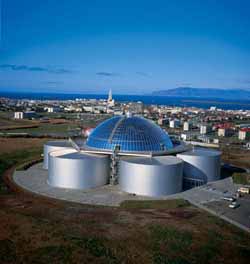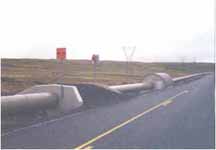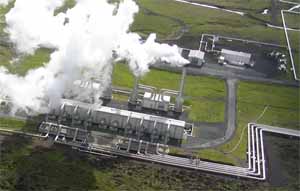
Perlan (the Perl) with Reyjavik in the background. Source Perlan Photo Gallery
Reykjavik, a City Powered by Geothermal
 |
Perlan (the Perl) with Reyjavik in the background. Source Perlan Photo Gallery |
Reykjavik means “smoky bay,” although the smoke for which it is named was actually steam from geothermal vents. Ancient records mentions the use of hot springs for washing and bathing including the well known Thvottalaugar (washing pools) in current day Laugardalur in Reykjavik (Lund 2005, 19). Reykjavik’s first geothermal district heating system was created in 1930 when a school, hospital, swimming pool and about 60 residential buildings were connected to geothermal energy. Reykjavik District Heating (now Reykjavik Energy) was established in 1943. In 1970, 43% of the Iceland’s space heating needs were met by geothermal. Today this number has increased to 89% (Thorsteinsson 2008, 26
 |
| Pipe transporting water from Nesjaviller power plant. Source: Lund 2005 |
There are 22 geothermal district heating systems in Iceland. Reykjavik’s Reykjavik Energy is by far the largest with over 190,000 users served by 93 wells. It uses low temperature resources in the city and environs as well as the high temperature Nesjavellir field 27 kilometers away. The geothermal water is used to heat fresh water which is distributed through the city for heating. There are roughly 1300 kilometers of distribution pipes in the city’s system, some of which date from 1940. In some case the waste water from the customers drains into the sewer system, but in others a double distribution system is used and the used geothermal water is cycled back to the pumping station to be reheated. The price of thermal water was about one third of heating oil in 2005. Reykjavik Energy’s Customers pay by volume so there is incentive to properly insulate their houses and to otherwise use thermal water efficiently. In 2005 85% of the thermal water supplied by Reykjavik Energy was used for space heating and 15% was used for washing and bathing (Lund 2005, 21).
Iceland’s geothermal industry has benefited from sustained federal support dating back to the 1940s and increasing significantly after 1967 when the “Icelandic” Energy Fund was established. The Fund offers loans for geothermal exploration and drilling, which become grants if the projects are unsuccessful. Subsidized loans are also offered to geothermal developers.
 |
Geothermal station near Reykjavik |
Removing much of the financial risk helped the industry develop and the need for federal assistance has decreased overtime. As in the U.S., interest in the resource was driven by rising oil costs. The oil crisis of the 1970s created pressure on the government to find indigenous energy sources because the country relied heavily on imported heating oil. The nation has reaped substantial environmental and economic benefits, “By switching from oil to geothermal energy for space heating, Iceland reduced its CO2 emissions in 2003 by approximately 37% and from 1970-2000 saved the Icelandic economy $8.2 billion in fuel purchases, or three times the Icelandic national budget in 2000” (Thorsteinsson 2008, 29). A city that once suffered severe air pollution is now one of the cleanest in the world.
It has been estimated that in 1960, the annual emission of greenhouse gases due to space heating in the Reykjavik area was about 270,000 tonnes. Today, this figure is about 12,000 tonnes [sic], all natural emission from the Nesjavellir high-temperature area. This is one of the main benefits of utilization of geothermal energy for space heating. Other benefits of the use of geothermal energy for district heating is that the energy is indigenous energy, it is relatively cheap and promotes cascading uses such as swimming pools, greenhouses, heated-garden conservatories and snow melting. (Lund 2005, 23)
The country has also tapped its geothermal resources to build numerous outdoor heated swimming pools. Reykjavik developed a man made beach heated by effluent from its district heating system. One of the nation’s biggest tourist attractions is the Blue Lagoon spa which also uses effluent from the Svartsengia combined heat and power (CHP) geothermal power plant that produces both electricity and hot water for district heating. The Blue Lagoon is just one of the nation’s many geothermal spas.